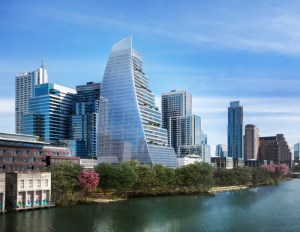Inside Austin’s Promising Pipeline: Q&A With Brad Maples
The Trammell Crow principal sheds light on the demand that’s driving development in the Austin metro area.
Due to their business-friendly environment and more affordable cost of living, Texas metros have been garnering increased attention from tech companies and other corporations in the past few years. Oracle and CrowdStreet Inc. are just a couple of examples of the big names that have chosen Austin to relocate their headquarters—a trend that translates to a growing need for new, modern office space.
According to CommercialEdge, some 8.8 million square feet of office space across 32 projects was under construction in the metro as of April. Trammell Crow Co. is developing two of the largest office projects in Austin.
One of them is Google’s roughly 800,000-square-foot Block 185 in the metro’s downtown, which will be one of Austin’s tallest office structures. Just a few blocks northeast, the company is also busy at work on Indeed Tower, a more than 700,000-square-foot, 36-story office building.
Trammell Crow Co. Principal & Business Unit Leader Brad Maples talked to Commercial Property Executive about the pandemic’s effect on the metro’s office pipeline and how he expects development to progress.
READ ALSO: Top Projects That Will Reshape Austin
How has the pandemic impacted your company’s office development strategy across the metro?
Maples: For the most part, our strategy has remained the same. We focus on delivering the highest quality office space in the very best locations in the most preferred submarkets in Austin. Obviously, we experienced a decrease in demand in 2020, but we were still able to convert new office leases on all of our projects during the pandemic. I think this supports our belief that the types of projects we aspire to deliver are best positioned to weather short-term demand challenges.
We will continue to monitor the recovery of the office market, which we think is already well underway, and we expect to continue to build more speculative office projects on a measured basis going forward.
How has the health crisis impacted your development activity in Austin? What were some of the challenges you encountered?
Maples: The pandemic impacted our business to varying degrees across the spectrum. On the construction side, we had to adapt quickly to implement appropriate safety protection measures to allow the work to continue in a way that maximizes worker safety.
On the leasing side, we experienced a significant drop in tenant activity, which was common across the entire country. Leasing activity has rebounded significantly since the start of 2021 and we’re extremely optimistic about the future of the Austin market across all asset classes.
We also experienced headwinds in capitalizing certain types of deals in the second half of 2020 as investors developed their go-forward strategy for a post-pandemic world. With the vaccine rollout in full swing, we are seeing a very sharp increase in investor interest for Austin deals.
What factors do you think are drawing so many tech companies to the metro?
Maples: As has been the case for the better part of the last 15-20 years, these companies are attracted to Austin, historically, for our amazing quality of life and pro-business environment. Our quality of life attracts a deep pool of highly educated talent to support these companies’ growth plans, and our cost of living and cost of doing business remain low relative to other historical tech-driven markets.
What submarkets have recently attracted the most attention?
Maples: For the last 10 years, downtown has probably attracted the most attention marketwide, and we expect that interest to remain and even increase as we enter the next cycle. East Austin and the Domain area are the two submarkets that have attracted the most “new” attention over the last five years, and we expect that interest to continue to grow as well.
Which submarket do you consider to have the most potential for growth?
Maples: We view the prospects for growth as very positive across all submarkets. Given the projections for job and population growth for the Greater Austin metro, we expect to see continued development in the adjacent suburban submarkets and an equal or potentially greater amount of urban infill development and redevelopment activity.
What amenities do you think Austin tenants will value most once employees start going back to offices?
Maples: I think we will see an expansion of what we were seeing prior to the pandemic. Before the pandemic began, the majority of Austin office tenants valued highly amenitized buildings in walkable environments with a special focus on quality outdoor spaces. As employers strive to attract workers back to the office, I think there will be an even greater focus on this aspect of their workplace strategies.
READ ALSO: Top 10 LEED-Certified Buildings in Austin in 2020
What changes do you expect to be permanent for the Austin office market in 2021 and beyond?
Maples: We believe the last cycle was an inflection point for the Austin office market and that we are poised for a long run of very robust and sustained growth. While still a smaller market compared to traditional gateway markets, the growth projections for the market are going to support much larger projects than we have traditionally seen here, and we are already experiencing unprecedented investor appetite for all asset classes.









You must be logged in to post a comment.